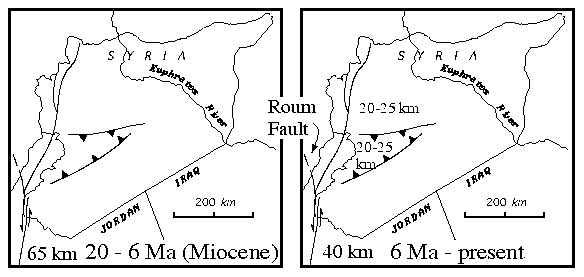
The Palmyride fold belt is a northeast-trending, 400 by 100 km transpressive belt in central Syria embedded in the northern Arabian platform, bounded to the north by the Aleppo plateau and to the south by the Rutbah uplift. Palinspastically restored cross sections from three transects across the Palmyride fold belt demonstrate a minimum NW-SE shortening of about 20% or 20 km across the southwestern segment of the belt, diminishing to 1-2 km in the northeast, close to the Euphrates graben system. The cross sections are based on the 1:200,000 scale geologic map of Syria and previously unavailable seismic reflection and well data, all provided by the Syrian Petroleum Company. These results differ significantly from those predicted by kinematic models of Middle East plate motions. In western Syria and eastern Lebanon the Palmyrides obliquely intersect (at about 45 degrees) the roughly north-trending Dead Sea transform fault system. The Dead Sea fault system shows well-documented evidence of 105 km of left-lateral displacement since mid-Tertiary time south of its intersection with the Palmyrides, yet only about 25 km of motion has been documented north of that juncture in Lebanon and western Syria. Thus, kinematic models of Middle East plate motions predict 80 km of shortening in Syria, most of which should be accommodated in the Palmyride fold belt. Several possibilities exist to explain the discrepancy between the 80 km of predicted shortening and the only 20 km of shortening measured from restored cross sections. Restored cross sections offer only minimum shortening estimates, so the calculated 20 km may underestimate shortening. Second, evidence of strike-slip displacement recognized in the field and reported in the literature, and indicated by new focal mechanism solutions of two recent earthquakes in the Palmyrides, indicates that some of the still "missing" displacement may be distributed throughout central and northern Syria as strike-slip motion oblique to the relative northward convergence of the Arabian plate on the Eurasian plate. Alternatively, previous estimates of slip along the northern segment of the Dead Sea transform fault system may be only minimum estimates. A final possibility is that the Dead Sea transform fault in northwestern Syria has been active for only the past 5-6 m.y. or so, implying that it was either nonexistent or moved only slightly before the Pliocene. This would suggest that there is a total of only 45 km of N-S convergence to be found in central and northern Syria, about 25 km on the Dead Sea fault system and about 20 km in the Palmyrides. This last possibility requires that the northern and southern segments of the Dead Sea fault system developed independently during most of the past 15-20 m.y. In light of the documented but unquantified strike-slip motion in the Palmyrides, it seems reasonable that strike-slip motion does accommodate a significant portion of the convergence between the Arabian and Eurasian plates. It is likely, however, that one or more of the other proposed mechanisms also accounts for a component of the expected 80 km of shortening.
Click here to view a PDF of the post-print
An edited version of this paper was published in the journal Tectonics by the American Geophysical Union. Copyright 1990 American Geophysical Union.
Figure 9. One possible kinematic model to explain the apparent discrepancy between left-lateral offsets observed on the segments of the northern versus the southern Dead Sea fault system. The Roum fault may have been the main northward continuation of the Dead Sea system during the Miocene. Displacements shown are net displacements.
